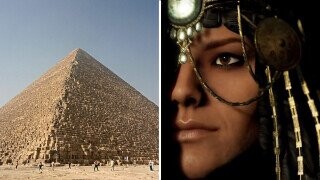The Time Assassin's Creed Research Predicted A Secret Room In An Egyptian Tomb

Assassin’s Creed games are beloved for their satisfying combat, fascinating stories, and prized above pretty much all other game franchises for their historical accuracy. The architectural design team at Ubisoft got so good at their jobs that there’s even an instance where the game included a controversial architectural detail. A detail that turned out to predict a paradigm shifting historical discovery: a secret room hidden inside the Great Pyramid.

ubisoft
The Great Pyramid of Giza is one of humanity’s greatest accomplishments (besides Elden Ring). It’s so fantastically big, standing upright and strong for thousands of years against the Egyptian desert, that there’s a lot of scholarly debate about how the pyramid was originally built. The prevailing theory is that a massive ramp was constructed outside of the pyramid, and was used as a pathway to haul massive stone slabs up around the walls to complete the structure.

Britannica
But French architect Jean-Pierre Houdin had another theory, that the pyramid had been constructed from the inside, with internal ramps spiraling upwards. The stone slabs were brought up through these passageways, wending their way through rooms big enough for them to be turned and placed into position.
Assassin’s Creed: Origins takes place in ancient Egypt. The team wanted to give players a historically realistic feel when walking around the cities and towns caught in the cultural tide shifting between Egypt, Rome, and Greece. Any good open world adventure game worth its salt is going to have some kickass dungeons, and what better place to delve for treasure than the pyramids themselves.

Ubisoft
So the team at Ubisoft began designing the internal workings of the pyramid. Some rooms they knew already: the Queen’s Chamber is a small room, the Grand Gallery is a long hallway, the King’s Chamber is where Khufu, the pharaoh commemorated by the Great Pyramid, was laid to rest. But when it came to the rest of the tomb, head AC historian Maxime Durand and the design team relied upon Hardin’s controversial theory of internal construction. Which meant that above the Grand Gallery leading to the King’s Chamber, there would be another room that was pivotal in construction of the monument.

ScanPyramids
When the game launched, players were free to explore the pyramids and discover the room for themselves. Less than a month after the release of the game, scientists using advanced scanning techniques discovered a massive open space in the pyramid… right above the Grand Gallery. Hardin’s internal construction theory got a win and Ubisoft got to pat itself on the back for not only making another beloved open world game, but for allowing players to touch a piece of previously undiscovered history. Who says you can’t learn anything from video games?